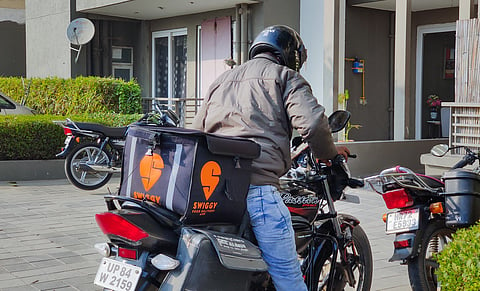Riders in the heat: India’s gig workforce at boiling point
The summers of 2024 and 2025 have brought some of the harshest heatwaves in India’s recent history. In many northern and central cities, the heat index climbed above 50°C, according to press releases from the India Meteorological Department. The burden of this climate reality is not only borne by crops, power grids, or urban residents—it is being carried, quite literally, by the workers who keep our cities moving. Delivery riders, cab drivers, sanitation staff, and app-based service providers have become the invisible shock absorbers of India’s climate crisis, working through blistering afternoons so others can remain indoors.
The distress among gig workers is no longer anecdotal. Reports from June 2024 documented multiple cases in Hyderabad where riders fainted outside restaurants or while waiting in cabs with no shade. In Delhi, a leading national daily found workers queueing at warehouses of major grocery and delivery platforms, drenched in sweat and wrapping wet scarves around their heads as they waited in 45°C heat. “If I don’t log in, I don’t earn,” one rider said. That simple equation—between survival wages and survival itself—captures the precariousness of India’s gig economy.
The National Disaster Management Authority (NDMA) has acknowledged this crisis. In July 2025, it issued a dedicated advisory for informal and gig workers, urging employers and local governments to restrict outdoor work between noon and 4 pm, ensure shaded rest areas, and provide water and first-aid facilities. The advisory explicitly recognised platform workers as among the most vulnerable groups in extreme heat.
Yet these protections often exist only on paper. Riders continue to report that they are compelled to stay logged in during the hottest hours to meet targets. On the ground, compliance is patchy, and enforcement is almost non-existent.
Some workers, who protested unsafe conditions, have faced retaliation. In Varanasi this year, about 150 gig workers went on strike to demand shade and hydration breaks. Rights monitors reported that several who participated found their accounts blocked by the platform—a form of digital punishment for asserting basic labour rights. This underlines the absence of an institutional safety net for workers who fall between the cracks of labour law.
The link between informality and vulnerability has never been clearer. Research published in January 2025 found that gig workers in Hyderabad routinely spend six to eight hours outdoors in 45-50°C conditions, often without access to toilets, shaded shelters, or healthcare. Unlike factory workers, there are no mandatory cooling breaks. Unlike office workers, there is no air conditioning. Unlike farmers, there are no crop insurance schemes. Gig workers stand at the sharpest edge of India’s labour precarity.
This is not only a humanitarian issue—it is an economic one. India’s gig workforce numbered 7.7 million in 2022 and is projected to reach 23.5 million by 2030, according to NITI Aayog. If heatwaves routinely incapacitate these workers, urban life will face delays in deliveries, driver shortages, and rising healthcare costs. International projections underline the scale of the threat: the International Labour Organization warns that by 2030 India could lose 34 million full-time jobs due to heat-stress-related productivity declines, while the World Bank estimates that heat stress could put up to 4.5 per cent of GDP—$150-250 billion—at risk, with more than 75 per cent of the workforce exposed to heat-related labour hazards.
The NDMA’s advisory is a start, and some states have experimented with “cooling centres” for outdoor workers; however, these remain pilot projects. What India urgently needs is a national heat-safety code for gig and informal workers, with legally enforceable provisions. Workers should be guaranteed rest breaks during high-risk hours from noon to 4 pm, access to water, shaded areas, and first aid at delivery hotspots such as restaurants, warehouses, and transport hubs. Insurance coverage for heatstroke and related health emergencies should be mandatory, jointly funded by platforms and the state. Importantly, workers must have a voice in planning and implementation to prevent punitive measures, such as account deactivations, against those who raise safety concerns.
Heat is no longer a seasonal inconvenience—it is a structural feature of India’s economy. Every parcel delivered, every meal carried, every ride booked in 48°C is a testimony to the human cost of climate adaptation borne by the most precarious.
India often celebrates its gig economy as a symbol of youth and digital disruption. But what is the value of such innovation if it rests on the scorched backs of workers collapsing on pavements? The urgent question is clear: will we allow climate change to turn gig workers into collateral damage, or will we adapt our labour protections to a hotter, harsher century?
Sushanta Kumar Mahapatra teaches economics at IFHE Deemed University, Hyderabad
Purna Chandra Padhan teaches at the Xavier Labour Relations Institute (XLRI) in Jamshedpur, Jharkhand, India
Muralidhar Majhi teaches economics at the School of Economics, Gangadhar Meher University, Sambalpur, Odisha
Views expressed are the authors’ own and don’t necessarily reflect those of Down To Earth

